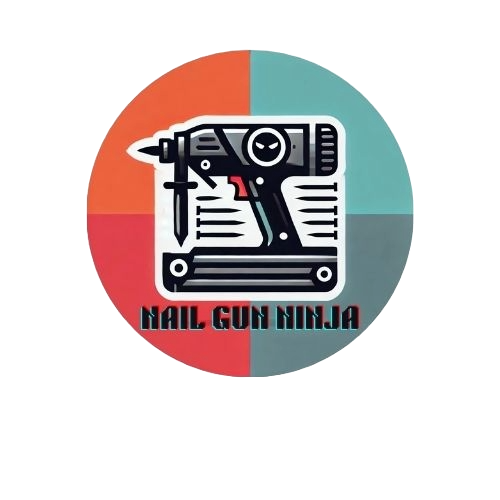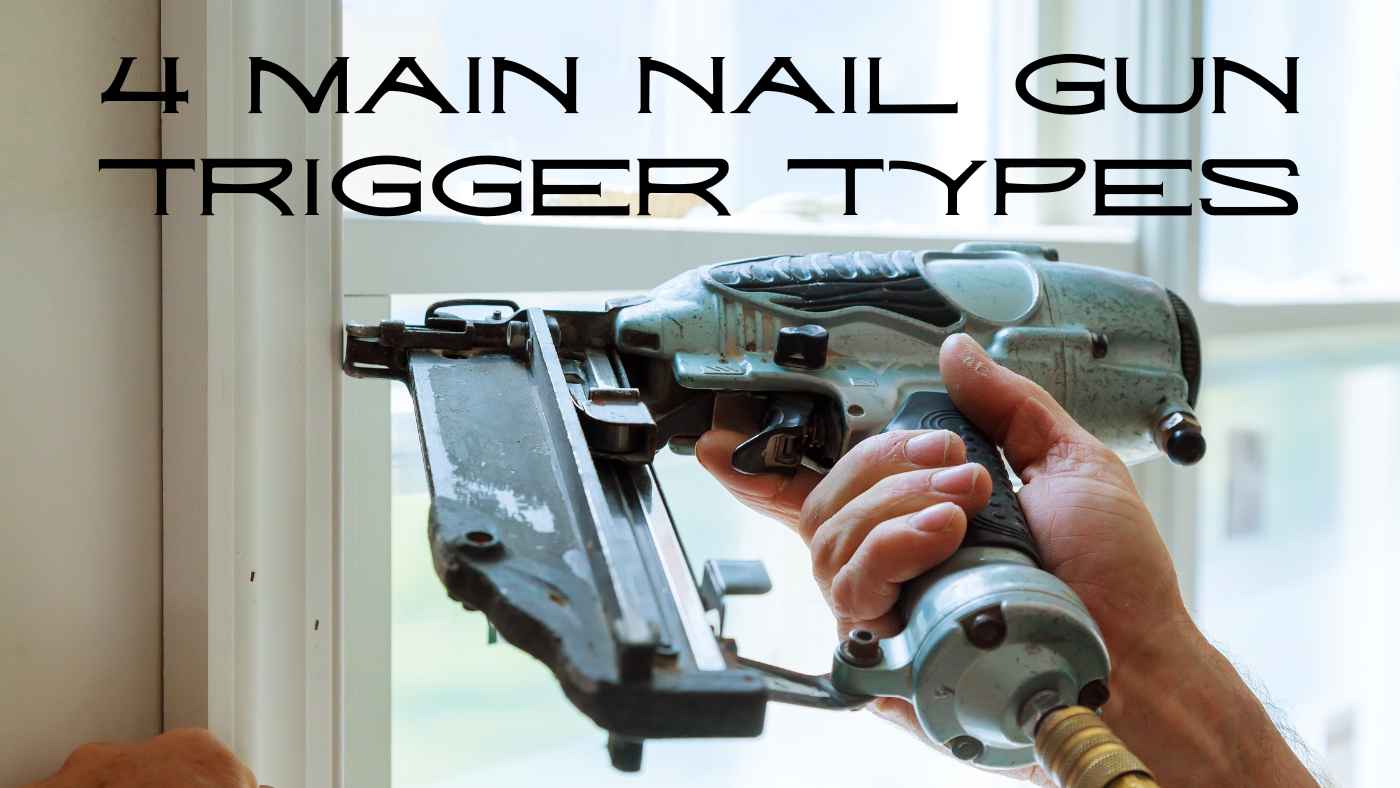The type of trigger on a nail gun plays a big role in how it works and how safe it is to use. Different nail gun trigger types allow users to control the speed and safety of the tool in different ways.
Each type of trigger has its own way of working. Some triggers require more steps to fire which makes them safer.
Other triggers fire faster but they may need more skill to use safely. It is important to understand these different trigger types to choose the right one for your task.
Why Nail Gun Trigger Matters?
Controls Firing Speed & Accuracy
Different triggers control how fast and accurate the nails are driven. A full sequential trigger gives the user better control.
It is best for precise work. A bump trigger lets the user fire nails quickly. It is great for large projects where speed is important.
Reduces Risk of Accidental Discharge
Choosing the right trigger reduces the chance of the tool firing unexpectedly. Accidental discharges can cause injuries.
The correct trigger prevents unintended firings, making the tool safer to use.
Prevents Common Nail Gun Injuries
Many injuries from nail guns happen because of the wrong trigger use. Double fires or unintended firings are common causes of injuries.
Knowing how to use the right trigger helps avoid these problems and keeps workers safe.
Safety Nail Gun Trigger Types – 4 Mode of Trigger
There are several nail gun trigger types in modern nail guns. But all triggers are not commonly used.
There are four mode of nail gun trigger which are available and widely used nowadays.
The 4 mode of Trigger:
- Full Sequential Trigger
- Bump or Contact Trigger
- Single Sequential Trigger
- Single Actuation Trigger
Here is a detail explanation of each nail gun trigger types for all users:
Full Sequential Trigger (Single Shot Mode)
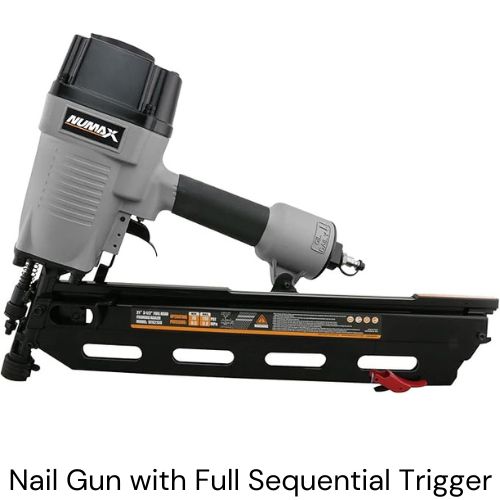
Requires a Two Step Firing Process
To fire a nail, the user must do two things. First, press the safety tip against the surface.
Then, pull the trigger. This process helps make sure the nail is fired intentionally and with control.
Prevents Accidental Discharges
The trigger will not fire unless the safety tip is pressed first. This feature reduces the chances of the tool firing by mistake. It makes this trigger the safest type to use.
Best for Precision Work
This trigger is best for jobs that need accuracy. It is great for framing, finish carpentry, and detailed woodworking.
It helps the user place nails in the right spot with care and precision.
Reduces Risk of Double Fires
Full sequential triggers do not fire multiple nails at once. Unlike bump triggers, this trigger ensures that only one nail is fired with each press of the trigger.
OSHA Preferred for Workplace Safety
Safety regulations, like those from OSHA, often recommend full sequential triggers.
These triggers are preferred, especially for new workers. They help reduce the risk of injuries on the job.
Slower Than Other Triggers
This trigger is slower compared to others. Each time you fire a nail, you must press the safety tip and pull the trigger.
This makes it less fast than bump triggers or other types, but it provides more control.
Ideal for Beginners
Beginners will find this trigger helpful because it offers more control.
It reduces the chances of mistakes, making it a good choice for first-time nail gun users.
Common in Framing & Sheathing Applications
While it is slower, the full sequential trigger is often used in framing and sheathing tasks.
Its high level of control and safety make it a good option for jobs that need careful nail placement, like building frames or decks.
Contact (Bump) Trigger: Fast but Risky
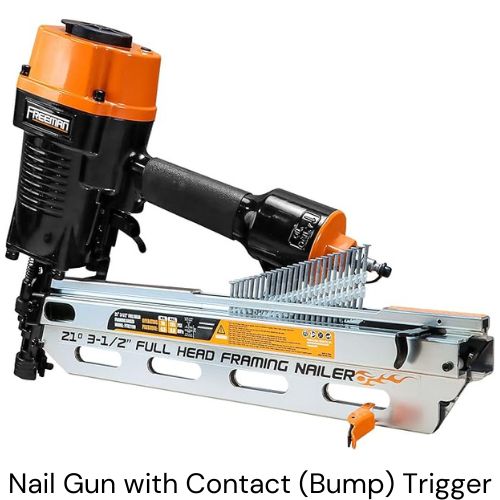
Fires Nails with Each Contact
The bump trigger fires a nail every time the safety tip touches a surface.
You must hold the trigger down while this happens. This is one of the fastest firing mechanisms.
Increases Nailing Speed
The bump trigger lets you fire nails without resetting the trigger each time.
This feature makes it great for large jobs. It is best for tasks like roofing or sheathing, where speed is important.
Higher Risk of Accidental Discharges
Because the trigger fires so easily, it can lead to unintentional firings. The speed of firing increases the risk of the tool discharging by accident. This is especially true in fast-paced jobs.
Requires Expert Handling
The bump trigger needs careful handling. Users must stay focused to avoid firing nails unintentionally.
If not controlled well, it can cause misfires or injuries.
Better for Experienced Users
The bump trigger is fast and needs good control. It works best for people who have experience using nail guns.
Experienced users can handle the speed and power of the tool more safely.
Common in High Volume Construction Jobs
The bump trigger is great for jobs that need a lot of nails driven in a short amount of time.
It is often used in large construction jobs like framing or decking, where speed is essential.
Potential for Misfiring in Tight Spaces
When working in small or tight spaces, the bump trigger can be hard to control.
This can lead to nails being fired in the wrong place or missed entirely.
Not Recommended for Finish or Detail Work
The bump trigger is not the best for delicate tasks. It works too fast and sacrifices control.
This makes it unsuitable for jobs that need precision, like trim or cabinet work.
Single Sequential Trigger: A Balance of Speed and Safety
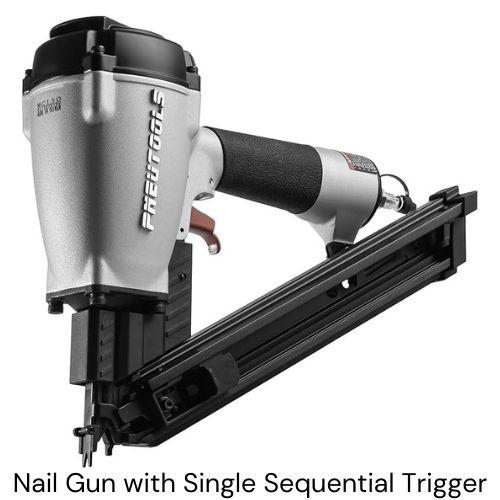
Press Safety Tip First, Then Pull Trigger
To fire a nail with the single sequential trigger, you must first press the safety tip against the surface.
After that, you pull the trigger. This process helps make sure the nail is fired safely. It allows for faster, continuous nailing.
Faster Than Full Sequential Trigger
The single sequential trigger is faster than the full sequential trigger.
It is quicker but still gives good control. It works well for jobs that need both speed and precision.
Lower Risk of Accidental Discharges
Even though the single sequential trigger is faster than the full sequential, it still needs intentional action.
This reduces the chances of the tool firing by mistake. It is safer than bump triggers, which can accidentally fire nails.
Ideal for Moderate Jobs
This trigger is great for jobs that require a balance between speed and accuracy. It works well for projects like framing, sheathing, and decking.
It is perfect for construction and renovation tasks that need efficiency and precision.
Allows Continuous Firing
Once you press the safety tip and pull the trigger, you can continue firing without resetting the safety tip each time.
This makes the process faster and more efficient while still offering control.
Safer for Less Experienced Operators
The need to press the safety tip first makes this trigger safer for people who are new to using nail guns.
It gives more control and reduces the risk of mistakes or accidents, especially for beginners.
Prevents Double Fires
The single sequential trigger ensures that only one nail is fired at a time.
Each time you press the safety tip, you will only get one nail. This helps prevent accidental double firing and misfires.
Versatile for Various Applications
This trigger works well for different types of work. It can be used for both framing and finishing tasks.
It is a good all-around option for people who need a reliable and balanced trigger for many types of jobs.
Single Actuation Trigger: A Hybrid Option
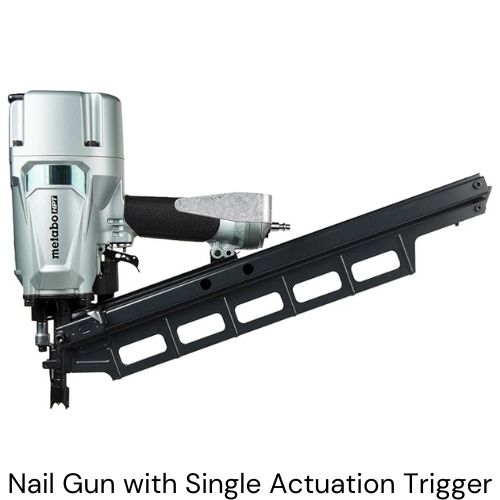
First Nail Requires Full Safety Engagement
To fire the first nail, you must press the safety tip against the surface.
Then, pull the trigger. This ensures that the first nail is fired safely and with control.
Subsequent Nails Fire with Just Trigger Pull
After the first nail, you only need to pull the trigger to fire the next nails.
You do not need to press the safety tip again. This makes the process faster and more efficient.
Blends Speed with Safety
The single actuation trigger combines the safety of a full sequential trigger with the speed of a bump trigger.
It gives you both control and fast firing. This makes it a good option for users who need both efficiency and safety.
Ideal for Repetitive Nailing Tasks
The single-actuation trigger is great for jobs that need lots of nails, like roofing or flooring.
It allows you to keep nailing continuously while still being safe.
Faster than Full Sequential but Safer than Bump Trigger
This trigger lets you work faster than a full sequential trigger. It also gives you more control than a bump trigger.
The initial safety step makes it safer than a bump trigger, but it speeds up the process compared to full sequential triggers.
Can Lead to Accidental Firing if Misused
If you do not handle the trigger carefully, you may fire more nails than intended.
If the safety tip gets pressed too hard or too often, multiple nails could fire at once. This requires careful attention.
Suitable for Semi Experienced Users
The single-actuation trigger is best for people who have some experience using nail guns.
It offers extra safety while allowing faster firing than a full sequential trigger.
Versatile for Both Large and Small Projects
This trigger works for many types of projects. It is good for big jobs like construction or smaller tasks like finishing carpentry.
It provides the right mix of speed and control for different job needs.
How Experience Level Affects Trigger Selection
Beginner Users Prefer Full Sequential Trigger
Beginners should use the full sequential trigger because it is the safest.
You must press the safety tip and pull the trigger for each nail. This prevents accidents and gives beginners more control over the tool.
Intermediate Users Find Single Sequential Trigger Ideal
People with some experience can handle the single sequential trigger well. This trigger lets you fire nails faster than the full sequential trigger.
However, it still requires a safety step, which gives a good balance of speed and control.
Experienced Users Thrive with Bump Trigger
Advanced users usually prefer the bump trigger. It is the fastest-firing trigger.
With enough experience, users can manage the fast pace and higher risk of accidental firing. This helps them finish large tasks quickly.
How Does Nail Gun Trigger Differ From Each Other?
| Factor | Full Sequential Trigger | Bump Trigger | Single Sequential Trigger | Single-Actuation Trigger |
| Firing Mechanism | Two steps: press the safety tip, then pull the trigger. | Fires whenever the safety tip touches the surface and the trigger is held down. | Requires pressing the safety tip and pulling the trigger for each nail. | Fires nail faster than full sequential, with only trigger pull after the first nail. |
| Speed of Nailing | Slower due to two steps per nail. | Fastest, continuous firing without resetting the safety tip. | Faster than full sequential but slower than a bump. | Faster than full sequential but slower than bump trigger. |
| Control and Precision | Provides maximum control and ideal for precise tasks. | Less precise | Good balance of speed and control. | Good balance of speed and control. |
| Safety Considerations | The safest trigger. Reduces accidental firing. | Riskier for beginners. | Safer than bump triggers but faster. | Safer than bump triggers but faster. |
| Ease of Use for Beginners | Easiest for beginners. | Requires skill and care. | Ideal for who need speed but want safety. | Ideal for who need speed but want safety. |
| Suitability for Different Projects | Best for precision tasks like framing or finishing carpentry. | Best for high speed tasks like roofing or sheathing. | Works well for tasks needing both speed and control. | Works well for tasks needing both speed and control. |
| Ergonomics | Easier to control, but can slow down work. | Can be tiring to use for long periods. | More comfortable for long jobs, offers flexibility. | More comfortable for long jobs, offers flexibility. |
| Cost | Usually more expensive due to added safety features. | Usually cheaper, simpler design. | More expensive than bump triggers, but offers better safety and control. | More expensive than bump triggers, but offers better safety and control. |
Pros & Cons of Each Nail Gun Trigger
Full Sequential Trigger
| Pros | Cons |
| Prevents accidental firing with a two-step process. | Slower firing Speed |
| Offers great control for precision tasks. | Not ideal for high volume jobs. |
| Meets safety standards to reduce accidents. | Pressing safety tips for each nail can tire users. |
| Only one nail can be fired at a time. | Increased effort required |
| Easier for new users to control. | Not ideal for fast paced jobs |
Bump Trigger
| Pros | Cons |
| Fires nails as fast as the tool is moved. | Can accidentally fire if not handled properly. |
| Ideal for Large Projects. | Harder to control, unsuitable for precise tasks. |
| No need to reset the safety tip after each nail. | In some cases may not meet all safety regulations. |
| Increase productivity by allowing faster completion. | Best for skilled and experienced users. |
| After getting used to the speed users can work quickly. | Can cause errors or misfires in tight or edged areas. |
Single Sequential Trigger
| Pros | Cons |
| Good mix of control and speed. | Slower than bump trigger. |
| Versatile for Various Tasks. | Requires re-engagement for each nail. |
| Reduces risk of accidental firings. | Engaging safety tips each time can tire users. |
| Meets safety standards for job sites. | Lacks precision for fine tasks. |
| Safer for semi experienced users | Can be less efficient for big jobs |
Single Actuation Trigger
| Pros | Cons |
| Fires quickly after the first nail. | Can fire multiple nails if safety tip isn’t re-engaged. |
| Combines precision and speed. | This can cause accidental firings if not handled properly. |
| Ideal for repetitive tasks | Still slower than bump trigger. |
| Offers a balance of speed and safety. | New users may struggle with the hybrid system. |
| Faster than full sequential, ideal for mid range projects. | Less control than full sequential |
Nail Gun Trigger Mechanisms
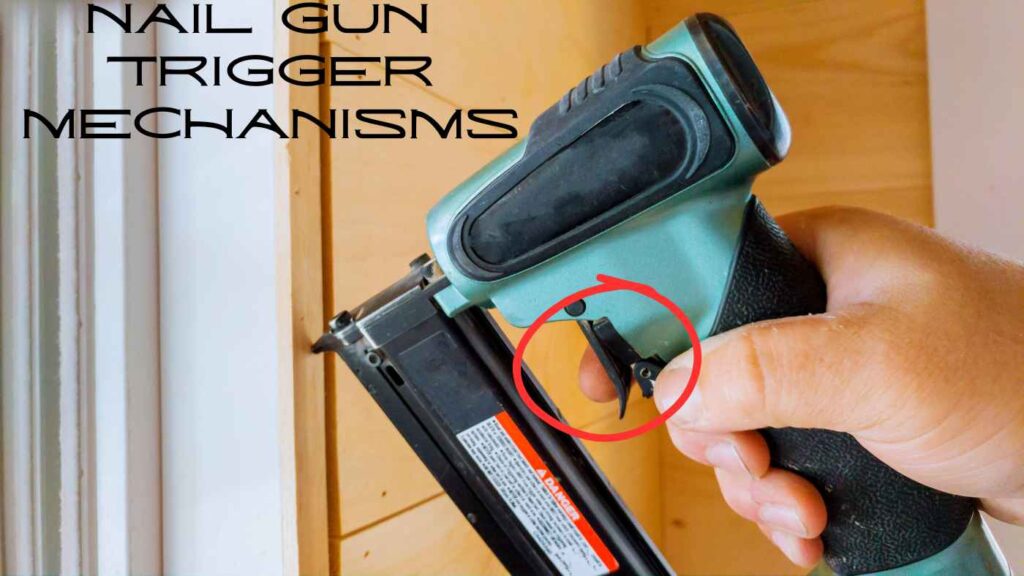
Full Sequential Trigger Mechanism
To fire a nail with this mechanism, you need to press the safety tip against the surface first. Then you pull the trigger.
This two step process ensures that you have full control and prevents accidental firing. It is one of the safest mechanisms to use.
Bump (Contact) Trigger Mechanism
The bump trigger mechanism works by firing a nail every time the safety tip touches the surface while the trigger is held down. This allows for fast firing speeds.
However, it also carries a higher risk of accidental discharges. It is best for high-speed tasks where volume is important.
Single Sequential Trigger Mechanism
This mechanism is similar to the full sequential trigger. To fire a nail, you must press the safety tip and pull the trigger.
However, after the first nail, you can just pull the trigger to fire the next nails. This makes it faster but still controlled.
Single Actuation Trigger Mechanism
This mechanism requires you to press the safety tip and pull the trigger to fire the first nail.
After that, you can fire nails with just the trigger pull.
This hybrid mechanism gives a good balance between speed and control. It is often used for repetitive tasks.
Selectable Trigger Mechanism
Some nail guns have a selectable trigger mechanism. This allows you to switch between different firing modes, such as full sequential or bump firing.
This gives you more flexibility and helps you adjust the tool for different tasks.
Smart Trigger Mechanism
Some advanced nail guns have smart triggers. These use sensors to detect how you are using the tool.
The smart mechanism adjusts the firing settings and helps prevent misfires. This makes the tool safer to use and reduces the risk of accidents.
Trigger Lock Mechanism
The trigger lock mechanism locks the trigger in place. This prevents the nail gun from firing when it is not in use.
It adds safety when you are carrying the tool or moving between tasks, ensuring that it does not fire accidentally.
Pressure Sensitive Trigger Mechanism
Some nail guns use a pressure-sensitive trigger. This mechanism changes the speed of firing based on how hard you press the safety tip against the surface.
The harder you press, the faster the gun fires. This feature helps you control the firing speed and adjust it for different tasks.
Conclusion
In conclusion, choosing the right trigger for your nail gun is important for both safety and efficiency. Understanding how each trigger works helps you decide which one is best for your project.
Safety for nail guns should always be your top priority. Always use the trigger that best matches your skill level and the task at hand.
Be sure to follow safety guidelines and keep your tool in good condition. Regular maintenance and proper use can reduce the risk of accidents.
With the right trigger, you can complete your projects with greater ease and confidence. Always remember to choose wisely and work safely.
FAQs
What are the four main trigger types of a brad nailer?
Ans: The four main trigger types of a brad nailer are:
- Full Sequential Trigger
- Bump Trigger
- Single Sequential Trigger
- Single Actuation Trigger
The full sequential trigger is the safest option.
Which type of trigger is used when bump firing or bounce nailing?
Ans: A bump trigger is used for bump firing or bounce nailing. When you press the safety tip against the surface while holding the trigger, the nail is fired.
This lets you fire nails quickly, but you must be careful to avoid firing by accident.
Are bump triggers suitable for beginners?
Ans: No, bump triggers are not good for beginners. They need more skill to handle without firing by mistake.
Beginners should use a full sequential trigger for more control and safety.
How do I choose the right trigger for my task?
Ans: Pick the trigger type based on your skill and the work you are doing. For precise work, choose a full sequential trigger.
If you need speed, a bump trigger or single actuation trigger may be better.
